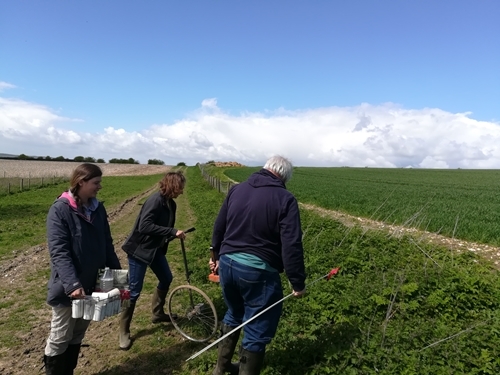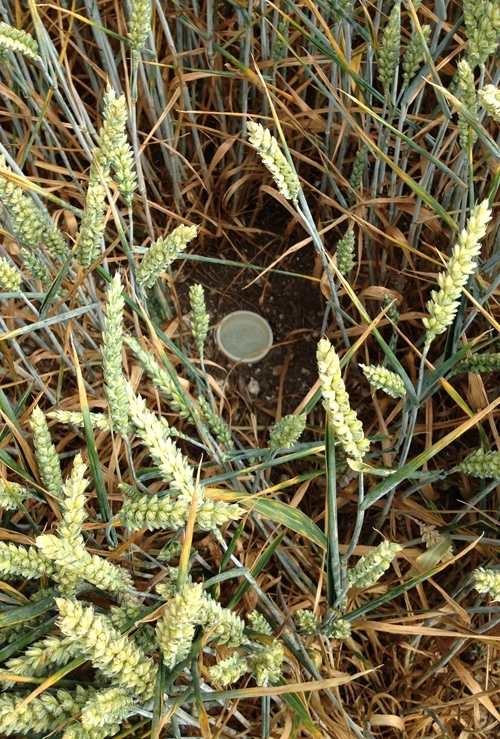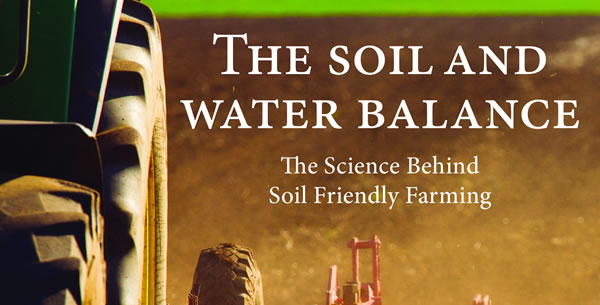A unique investigation into changes to ground beetle communities over 40 years has shown results which suggest large scale changes related to agricultural practices
By Susan Hammond, MSc Entomology, Harper Adams University

Figure 1: (L to R) Megan Baldissara, Susan Hammond and Steve Moreby
setting pitfall traps in Winter Wheat (April 2018) (Credit Julie Ewald)
Between 1972 and 1974, Dick Potts and Paul Vickerman from The Game Conservancy (as was) sampled ground beetles on a farm in Sussex. This was a time of great changes in farming, and Dick and Paul intended this work to show how farmland beetles reacted to these changes. The samples were recovered in 2015 and Dick realised that this provided a unique opportunity to rerun the sampling and see how things had changed more than 40 years later.
Dick set the wheels in motion for this comparison, gathering the first year of data in 2016 for what he planned to be a three-year project. He identified the beetles from the 1970s and 2016. Following Dick’s untimely passing in 2017, the GWCT’s Entomology and Sussex teams set pitfalls in 2017, and this year I was involved in setting and picking up traps, as well as identifying ground beetles collected in 2017. Pitfall traps are pots dug into the ground filled with water – designed to capture beetles as they move across the ground. The recent ones are set in the same locations, fields and types of crops as in the 1970s. They were collected and reset weekly between late April and harvest at the end of July/early August.
Many ground beetle species are beneficial, predating on insect pests or slugs and, in turn, are prey items for many bird species. Their range of feeding, breeding and dispersal strategies makes them an ideal group to help understand the impacts of farming practices.

Figure 2: Pitfall trap set in Winter Wheat (July 2018) (Credit Susan Hammond)
Comparing the results from 2016 and 2017, we found that, rather than declining, as might be expected because of the intensification of agriculture, ground beetle numbers have actually increased fourfold. Individual species fared differently. Around half of all species found were present at both time periods – 14 species increased, eight decreased and two remained the same. 13 species present in the 1970s were not found in the 2010s, whilst nine new species were found in the 2010s. The most prevalent species in both decades was the large predator, Pterostichus melanarius. Whilst in the 1970s it accounted for 30% of all individuals, by the 2010s it accounted for 75% of all beetles collected. The size of beetles varied significantly: In the 1970s most were small or medium sized, whereas in the 2010s most species were large.
The main factors influencing ground beetle survival are the application of foliar insecticides; herbicides that affect cover and food; tillage; and quality of field boundaries for overwintering. Of particular interest on this farm are the increase in the number of field margins and other habitats that provide a wider range of overwintering habitats, as well as a reduction in the intensity of soil tillage, which will particularly favour Pterostichus melanarius (the predominant species in the 2010s), because the larvae overwinter in the soil. This farm has also instigated a programme of organic manures, which may provide a more favourable environment for ground beetles.
Dick Potts (1939-2017) was the Director General of the Game Conservancy Trust between 1993 and 2001. His research was instrumental in understanding the links between farmland bird survival and agricultural practices (full obituary). The Dick Potts Legacy Fund was set up in his memory to support early career scientists to continue research in areas that Dick was passionate about. This work has been financially supported by the Dick Potts Legacy Fund, for which I am very grateful.
Many thanks to John Holland and Julie Ewald for encouragement and guidance.

Get the inside track on soil and water research
Priced now at just £4.95 (50% off), The Soil & Water Balance is a handy paperback which provides the inside track on soil and water research.
Presented in a Q&A style, much like our popular Moorland Balance, this 100-page book looks at the problems and solutions on topics ranging from erosion and contamination, to the impact on songbirds and other wildlife.
Combining years of research at the GWCT's Allerton Project demonstration farm with tens of external scientific papers, this is a fascinating study of how farming can adapt to the challenges it currently faces.
View Book >
or
Buy Now - £4.95 >
100% Secure. All Credit & Debit cards, PayPal, Apple Pay and Google Pay accepted.
